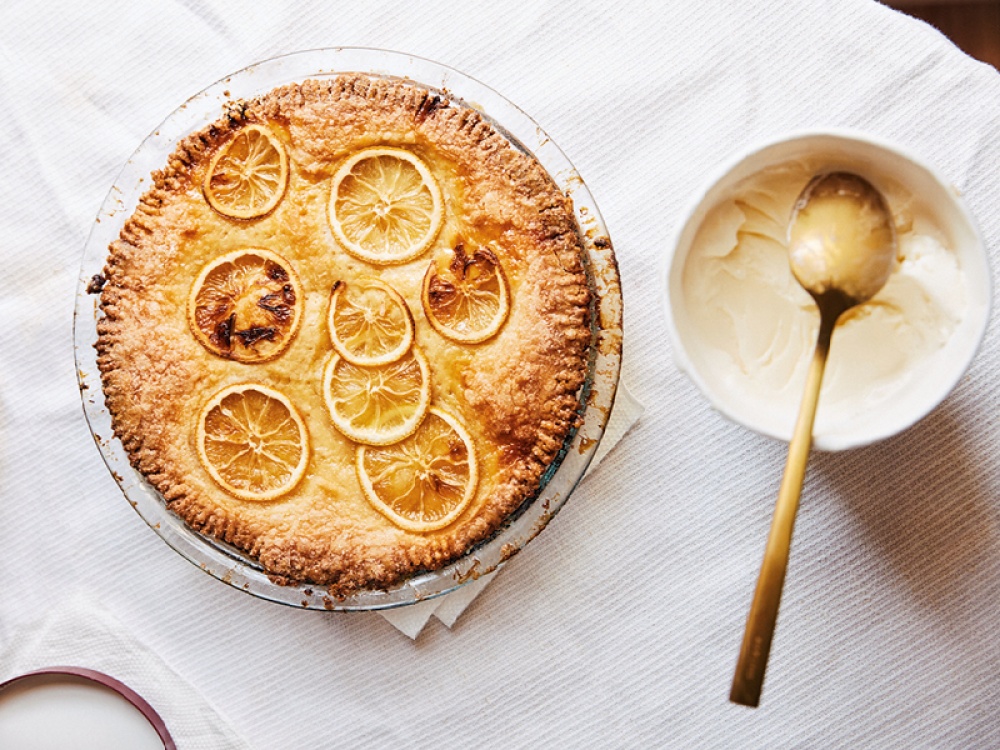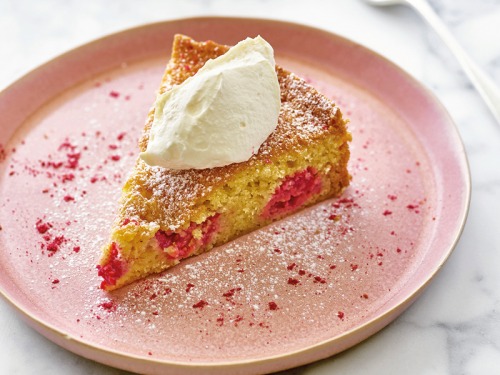Lemon Shaker Pie Recipe

- 2 Meyer or large regular lemons (about 300g), very thinly sliced and seeded
- 260g sugar, plus more for sprinkling
- good pinch of kosher salt
- 4 large eggs
- 35g plain flour, plus more for dusting
- 2 discs The Only Pie Crust (see right)
- Serve with
- Thick clotted cream, mascarpone or crème fraîche
Set aside a few lemon slices to put on top of the pie. In a medium bowl, combine the remaining slices with the sugar and salt. Toss to coat, then let sit at least two hours, up to 24 hours, refrigerated.
Preheat the oven to 180C. Remove the lemons from the fridge and whisk in three of the eggs and the flour.
Dust a work surface with flour. Roll out each disc of dough to a round, about 35cm in diameter. Lay one into a 23cm pie dish, letting the dough slump into the edges, leaving the overhang. Pour the filling into the crust.
Use a paring knife to cut a few vents into the other dough round, or simply prick it all over with a fork. Drape it over the pie filling, then, using your thumb and forefinger, press the top and bottom crusts together to seal them. Using the tines of a fork, press the crusts together onto the pie dish, creating an even tighter seal. Then, using a knife or scissors, trim any excessive overhang.
In a small bowl, whisk the remaining egg with about a teaspoon of water. Brush the pie all over with the egg wash and arrange the reserved lemon slices on top. Sprinkle the whole thing with sugar.
Bake until the crust is deeply golden and evenly browned, one hour 10 minutes to one hour 20 minutes. Let cool at least one hours before serving.
Do ahead: This pie can be made three days ahead. Wrap and store at room temperature or refrigerate.
I believe in this recipe so much that I keep republishing it every chance I get, in every book I write. It’s flaky, it’s buttery, it doesn’t require a food processor (in fact, I’d recommend against using one), and 98 percent of people who have made it have success with it 100 percent of the time. My tip here is to resist the urge to add more water – pie dough should never look like a smooth, shiny dough.
The flour in the dough will hydrate as it sits, transforming from shaggy to more supple once rested. Remember, pie crusts are meant to be flaky, shatteringly crisp. Not doughy or cookie-like. Keep that in mind when the dough looks, well … flaky. That’s a good sign!
Makes two discs
360g plain flour, plus more for rolling
2 tsp sugar
1 tsp kosher salt
285g unsalted butter, cut into 2.5cm pieces, chilled
1 tbsp apple cider vinegar or distilled white vinegar
60g ice-cold water, plus more only if you absolutely must
In a large bowl, whisk together the flour, sugar and salt. Add the butter and toss to coat it in the flour mixture. Using your hands, smash the butter between your palms and fingertips, mixing it into the flour, creating long, thin, flaky, floury, buttery bits. Once most of the butter is incorporated and there are no large chunks remaining, dump the flour mixture onto a work surface.
In a measuring cup, combine the vinegar and icy water and drizzle it over the flour mixture. Run your fingers through the mixture like you’re running your fingers through your hair, just to evenly distribute the water through the flour until the dough starts coming together.
Knead the dough a few more times, just to gather up any dry bits from the bottom and place them on the top to be incorporated. You will be tempted to add a tablespoon or two more water now – resist if you can, add only if you must.
Once you have a shaggy mass of dough (it will not be smooth and it certainly will not be shiny), knead it once or twice more and divide it in half. Pat each piece into a flat disc about 2.5cm thick.
Wrap each disc individually in plastic wrap. Refrigerate at least two hours.







